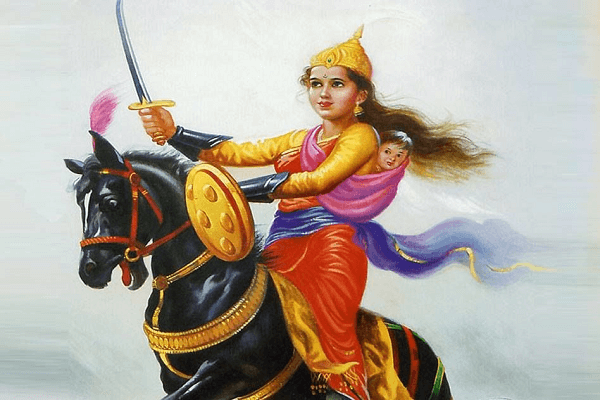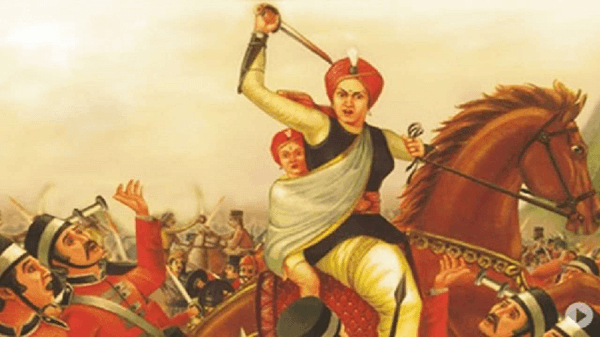Rani Lakshmi Bai EssayRani Virangana Lakshmibai of Jhansi, who helped make Indian Vasundhara very happy, was the perfect female character in the real sense. Rani Lakshmi Bai was known as Manu Bai before marriage. Manu Bai, also known as Manikarnika, was the daughter of Moropant Tambe and Bhagirathi Tambe, born on November 19th 1828, in Kashi (Varanasi). At the age of 3-4 years old, Manu Bai lost her mother and was subsequently brought up by her father on his own. Following the demise of her mother, Manu Bai, along with her dad, moved to Bithoor and were housed in Peshwa Baji Rao's palace. Early LifeRani Lakshmibai was born in Varanasi, India, in a Marathi Brahmin family. The nickname she was given was Manu. Her father was an official in the court of Peshwa of Bithoor who loved Lakshmibai. He adored her, called her "Chhabili", meaning "playful", and took care of her as his daughter. Lakshmibai had an unusual childhood compared to the majority of women in her time. Growing up in the family of the Peshwa, she was able to receive education at home that included instruction in martial arts such as sword fighting, horsemanship, as well as fencing and shooting. She also studied Mallakhamba alongside her childhood friends, such as Nana Sahib and Tantia Tope. 
Marriage and Annexation of JhansiIn May 1842, Manikarnika became the wife of Maharaja Gangadhar Rao Newalkar, who was the Maharaja of Jhansi. Later, she was given the name Lakshmibai (or Laxmibai) after the famous Hindu goddess Lakshmi. She gave birth to a boy in 1851 and named him Damodar. Sadly, he passed away in infancy when he was four months old. Without any heirs, the Maharaja adopted one of his relatives. The child, who was originally named Anand Rao, was given the name Damodar Rao a day before Maharaja's death. The Maharaja supervised the adoption process with a British political officer present and wrote a letter to the officer that gave instructions to take care of the child. In the letter, the Maharaja said that upon his death, his widow, Lakshmibai, is to be granted the status of a government of Jhansi throughout her life. The Maharaja's death occurred in November 1853. Following that, the British East India Company, refused to recognize Damodar Rao as the heir because he was adopted. This was known as the 'Doctrine of Lapse'. Britishers annexed the state of Jhansi. The course of events angered Lakshmibai, who was popularly known by the name "the Rani of Jhansi". She was determined not to surrender Jhansi to the Britishers. The British demanded that Lakshmibai leaves Jhansi castle, after which she would receive a yearly pension of 60,000 in March of 1854. Rani Lakshmibai and The Revolt of 1857Known in history as the first major protest against British rule, the Indian Rebellion of 1857, was the first time that Indians showed some kind of resistance to British Rule in India. It started as a sepoy mutiny in opposition to the British East India Company in the garrison town of Meerut on May 10th, 1857. In the meantime, Lakshmibai was not rebelling against the British and actually had requested permission from British Political officer Capt. Alexander Skene built a group of men with guns to protect her, and he acceded. The flames of the revolt were quickly spreading throughout several cities of north India. A number of discontented landlords and the rulers of estates owned by princely families began to rebel against British forces. In 1857, the rebels of the 12th Bengal Native Infantry seized the fort of Gwalior and then massacred a number of European soldiers and their families. Lakshmibai's role in the incident remains a mystery and disputed to this day. The sepoys fled Jhansi with a large sum of money from Lakshmibai's family and threatened to demolish her home. Following the incident, Lakshmibai was appointed as the head of city administration and reported this incident in writing to the Commissioner in charge of the Saugor division, Major Erskine. Erskine replied on July 2nd, asking her to run the district for the British Government until the British Superintendent was appointed. As a result, Lakshmibai had the task of defending Jhansi against mutineers along with Company Allies, Datia and Orchha. Her plea to the British for help was ignored, and the governor-general deemed her to be the one responsible for the massacre. However, this did not deter the determined Lakshmibai from defending Jhansi no matter what. She established a foundry to cast cannons to be used to protect the walls of the fort. She also gathered forces that comprised ex-feudatories as well as mutineers. They were able to defend Jhansi against invaders in the month of August. Jhansi was then ruled by Lakshmibai till January 1858. 
The British had made a public announcement to deploy troops in Jhansi. However, the troops were not there for a long time. A section of Lakshmibai's advisors and supporters, who wanted to liberate Jhansi from British control, bolstered their position. When British troops finally made it to Jhansi in March 1858, they were awed by the type of defence that was set by Jhansi's city. The fort was armed with powerful guns that could shoot throughout the town. Sir Hugh Rose, who was in charge of the Central Indian Field Force, announced that if the town were not surrendered, it would be knocked down. At this point, Lakshmibai announced she would fight to win back their independence until the end of time. She fought British soldiers to defend Jhansi after Rose took it on March 23rd 1858. She fought a hard battle against the British forces and received assistance from Tantia Tope. Although her troops were defeated by the British, Lakshmibai refused to give up. The brave Rani took off from the fort on her horse Badal and Damodar Rao riding on her back and was able to escape at night, escorted by her guards. Other warriors who escaped with them were Dee Lala Bhau Bakshi, Moti Bai, Deewan Raghunath Singh, Khuda Bakhsh Ali (commandant), as well as others. After exiting the fort, they headed to the east and west to Kalpi, where other rebels like Tantia Tope joined her. They were able to capture Kalpi; however, British forces attacked the town on May 22nd, 1858. Lakshmibai was the leader of the Indian forces against the British, but they were unable to gain ground. Lakshmibai, Nawab of Banda, Rao Sahib, and Tantia Tope went to Gwalior and joined the remaining Indian forces. They succeeded in occupying Gwalior without fighting and then led an assault against the city fortress of Gwalior in, capturing its treasury as well as the arsenal. Then, Nana Sahib was officially announced as the Peshwa (ruler) with Rao Sahib as his governor. Lakshmibai however was expecting an attack from the Britishers on Gwalior but was unable to persuade the other Indian leaders to plan their defence. Lakshmibai's prediction proved correct when the British forces led by Rose launched a successful assault on Gwalior after they captured Morar on June 16th of the same year. Passing Away Of The LegendLakshmibai was the leader of a fierce fight against Britishers in Gwalior. According to certain sources, Lakshmibai, dressed in an armoured sawar's outfit, was killed after a soldier "dispatched her by using his gun". Some sources claim that the Rani dressed as the leader of the cavalry, and when she was badly wounded, she requested an errand boy to burn the body to ensure that the British could not take it. After her death, her body was cremated by a handful of locals. According to Rose, Lakshmibai's remains were ceremoniously laid to rest under a tamarind tree beneath the Rock of Gwalior. ConclusionDue to her courage, strength, and determination, her innovative idea of the liberation for women in India during the 19th century, as well as her deeds, she became a significant icon in the Indian freedom movement. The Rani was immortalized in bronze sculptures in Jhansi and Gwalior, each depicting her riding on horseback. In modern times, society is grappling with the illiberal notions of gender equality. Rani Lakshmibai received proper education as a child and was proficient in not just reading the scriptures but also holding an arm of the same strength as an adult. The woman fought to defend the rights of an adopted child, the rights of women to be the ruler of the kingdom when her preferred heir was a minor, the rights of females to be able to dress in military uniforms, the right to live and rule instead of becoming sati, and the rights of every citizen of her kingdom, whether male or female, Muslim or Hindu, to take part in the fight for freedom. She was not just a strong-willed woman but a true patriot and fighter. She did not just fight for the rights of her child and Jhansi but the whole nation. Her name will remain engraved in Golden letters in the pages of the history of the Indian Freedom Struggle.
Next TopicTravelling
|
 For Videos Join Our Youtube Channel: Join Now
For Videos Join Our Youtube Channel: Join Now
Feedback
- Send your Feedback to [email protected]
Help Others, Please Share










